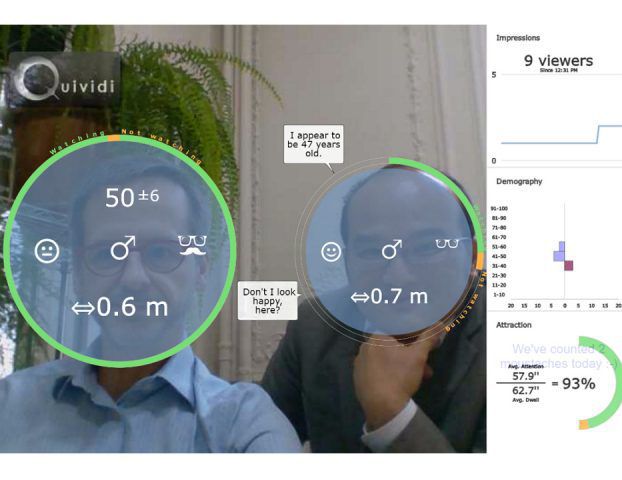In the first week of this month, a train passenger discovered a camera on an advertising pillar at the train station of Amersfoort (NRC, 2017). She posted a photo of it on Twitter and this triggered a big discussion. People are concerned about their privacy. This post is about this recent hot topic.
The advertisement pillar with camera is exploited by Exterion Media. Exterion owns hundreds of pillars with cameras and they are experimenting with this type of advertisement. Due to the high software expenses of the system they use, VidiReports, most of the cameras were still switched off (NOS, 2017).
VidiReports is owned by Quividi and this software combines multiple features. First of all, it analyzes the scene by showing the number of by-passers. Secondly, it provides face detection to count the watchers. Moreover, it measures the attention time of those watchers and the more global dwell time, which includes the moments when they were looking away. Another function of the software is that it can qualify faces by estimating the gender, the age, the face features and the mood of the watchers. The last function is gate crossing, to estimate the number of people who cross a virtual gate, when the camera is set on the ceiling (Quividi, 2017).
All these features can provide valuable insights for advertisers, since they can measure the effectiveness of their advertisements. But following the discussion after the discovery of the cameras on the advertisement pillars, Exterion has decided to switch all cameras off. The promise of not saving any camera images was not enough to stop the discussion. A spokesperson from the authority of personal data states that in general the use of cameras in public spaces for advertisement purposes is prohibited (Volkskrant, 2017).
This is an important topic, since through advanced technologies cameras are more and more used in order to provide valuable insights. Cameras are not only found in advertisement pillars. An increasing number of objects are equipped with cameras like for example public lightning.
What is your opinion about the use of cameras in advertisement pillars or in public spaces in general? Do you see it as an infringement of privacy or do you see it as a great tool to provide customer insights?
To see how VidiReports work, watch this video:
https://www.youtube.com/watch?v=EekdBMSWf_Y
References:
Schellevis, J. (2017) Reclameborden op A’dam CS weten wanneer en hoelang jij kijkt. [online] NOS.nl. Available at:https://nos.nl/artikel/2191341-reclameborden-op-a-dam-cs-weten-wanneer-en-hoelang-jij-kijkt.html [accessed 27 September 2017].
Sondermeijer, V. (2017) Exploitant schakelt cameras in reclamezuilen uit [online] NRC. Available at: https://www.nrc.nl/nieuws/2017/09/11/exploitant-schakelt-cameras-in-reclamezuilen-uit-a1573012 [accessed 27 September 2017].
Verhagen, L. (2017) U wordt gefilmd (en uw emoties gemeten): wat doen die camera’s in billboards op stations? [online] De Volkskrant. Available at: https://www.volkskrant.nl/tech/u-wordt-gefilmd-en-uw-emoties-gemeten-wat-doen-die-camera-s-in-billboards-op-stations~a4514861/ [accessed 27 September 2017].
http://www.quividi.com/products-services/


Hi Anneline, thank you for your interesting blog post about the cameras on advertisement pillars. I also read the article in the NOS a few weeks ago about these camera, but I did not know that they were so great and complicated! It is really interesting that advertisers use these cameras to detect so many insightful information about us, the consumers/watchers. I would let them analyze my behavior, age and so on just for once, because of their awesome software.
However, these cameras would benefit the advertisement market very well, although we still need to consider our privacy as stated in your blog. People are getting more and more concerned about their privacy and are not willingly to be filmed and analyzed by marketers. (Wu et al., 2014) So I think this is an infringement of privacy, simply because people are getting filmed and analyzed without their approval. This opportunity would also give more power to advertisers, because of the many insightful information provided, though that would be another discussion.
Wu, X., Zhu, X., Wu, G. Q., & Ding, W. (2014). Data mining with big data. IEEE transactions on knowledge and data engineering, 26(1), 97-107.
Thanks Anneline for your post about this interesting subject. As you are asking my opinion about this subject, I can say that I would encourage these new ways of advertising as long as the data collected by the billboards does not allow recognizable material regarding a tracked person. According to Extertion, this is not the case. They even announced that the images are not stored. Next to that the legality of the cameras is still unclear in our country (Solanki, 2017). Our government should start initiating such laws regarding this topic. In my opinion it is not truly fair of Civil Liberty Organizations to point fingers to these advertisers. They should look at the government and face the lack of regulations regarding this subject. These days it is unavoidable that because of the current technological revolution new innovations, also regarding advertisement, will occur.
Reference:
Solanki, M. (2017). Hidden cameras in Dutch advertisement billboards at NS train stations can see you. Iamexpat.nl. Retrieved 21 October 2017, from https://www.iamexpat.nl/lifestyle/lifestyle-news/hidden-cameras-dutch-advertisement-billboards-ns-train-stations-can-see-you